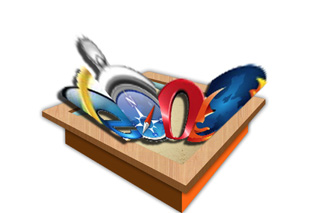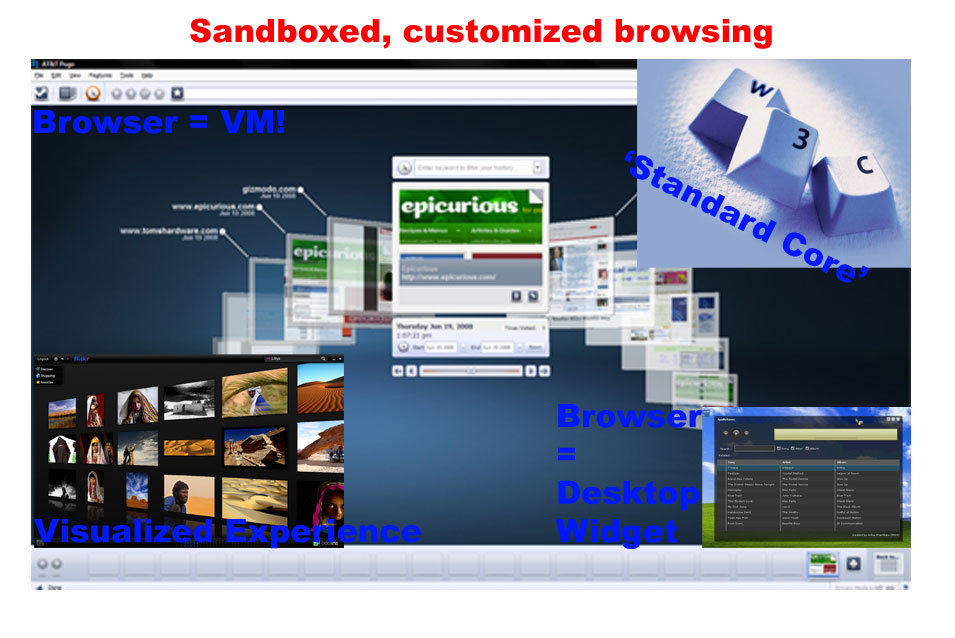Difference between revisions of "Scenario 4, SandBoxMania:"
| (11 intermediate revisions by the same user not shown) | |||
| Line 1: | Line 1: | ||
<h2 style="background-color: #F5F9FA; border-left:1px solid #AAAAAA;border-right:1px solid #AAAAAA; padding-left: 10px;">SandBox Mania</h2> | <h2 style="background-color: #F5F9FA; border-left:1px solid #AAAAAA;border-right:1px solid #AAAAAA; padding-left: 10px;">SandBox Mania, a visualized secure Internet experience</h2> | ||
[[Image:sandboc.jpg]] | |||
<br> | <br> | ||
The internet as we know it today, and especially the internet experience is in fact a very immature way of retrieving and sending information. Corporate and social environments tend encourage people to do more and more of their work using this 'new' medium. It seems however, that everybody agrees in abandoning the 'Internet-way' of communicating at certain occasions. Then it is time for a real Face2Face meeting. Visual expressions and body language, in short terms: Visual Data is still very important for us! | |||
<br> | |||
This immediately shows one of the major problems of the Internet today. Using the Internet, personal communication is possible. The problem however is that most of the data as it is presented to he user, is based on text. Images and videos are used separately in order to provide us with a picture of what is meant in the text. The future Internet use will be like walking trough an airport. Searching for the proper hall by using Icons that are backed-up by one or two words. | |||
<br> | |||
<br> | |||
Another big change will come from the developers' corner. Currently development focus is shifting to open source software. Software of which the quality cannot always be guaranteed. Commercial software developers, during the past ten years have tried to live up to the demand for the use of open source software by creating 'Virtual Machines'. These are virtual environments on top of the computers' operating system in which applications can run. The Virtual Machine limits the type of operations an application can carry out on the operating system, e.g. the use of the filesystem, accessing the internet or using a webcam. | |||
<br> | |||
This upcoming trend for Virtual Machine 'sandboxes' is creating a completely new business model for the manufacturers of the operating systems. Because they do no longer have to worry about the security of 'home grown' applications, they shift their emphasis to enabling more and more people to develop for their 'sandboxed' platforms. Money is now made by selling the development tools to the open source community and by providing support about the technical possibilities of their sandbox. | |||
<h2 style="background-color: #F5F9FA; border-left:1px solid #AAAAAA;border-right:1px solid #AAAAAA; padding-left: 10px;"> | <h2 style="background-color: #F5F9FA; border-left:1px solid #AAAAAA;border-right:1px solid #AAAAAA; padding-left: 10px;">10 Years from now</h2> | ||
The current browser is mostly used as a 'window to the internet' an application to view webpages and some 'web enabled media'. To play video files and to chat, we still use separate applications. Within ten years from now, this will be fully integrated in the browser. The storage of data online will enable this. Browser developers will use one standardized core that runs in a sandbox and that will enable users to also become developers of browser plug-ins. | |||
<br> | <br> | ||
<br> | <br> | ||
The standard browser core will itself be virtual machine to internet applications, and it will erase the fine line between on-line and off-line browsing. In fact, 'browsing' will be the new term for using a computer. | |||
The | |||
<br> | <br> | ||
Because of the virtual machine presence, using the browser will no longer be a separate application that mimics paper, it will be a desktop application that always runs and displays content the way we want it. Web pages can be opened and stored as widgets and will be composed mostly out of visualized data. | |||
<h2 style="background-color: #F5F9FA; border-left:1px solid #AAAAAA;border-right:1px solid #AAAAAA; padding-left: 10px;">Conclusion</h2> | <h2 style="background-color: #F5F9FA; border-left:1px solid #AAAAAA;border-right:1px solid #AAAAAA; padding-left: 10px;">Conclusion</h2> | ||
Due to the larger role of the virtual machine, a more visualized and human-friendly Internet experience will be there within 10 years. Technical innovations together with the shift in power from software developers to software users, the internet will be what each user wants it to be. Writing plugins will for the browser will be enabled for everybody and the browser can look like however we want. If you still prefer the windowed look with an addressbar as we use it now, it is no problem, customization is king because of secure sandboxing. | |||
<h2 style="background-color: #F5F9FA; border-left:1px solid #AAAAAA;border-right:1px solid #AAAAAA; padding-left: 10px;"> | <h2 style="background-color: #F5F9FA; border-left:1px solid #AAAAAA;border-right:1px solid #AAAAAA; padding-left: 10px;">Visual Representation</h2> | ||
[[Image: | [[Image:Visualized_Browsing.jpg]] | ||
Latest revision as of 10:11, 8 May 2009
SandBox Mania, a visualized secure Internet experience

The internet as we know it today, and especially the internet experience is in fact a very immature way of retrieving and sending information. Corporate and social environments tend encourage people to do more and more of their work using this 'new' medium. It seems however, that everybody agrees in abandoning the 'Internet-way' of communicating at certain occasions. Then it is time for a real Face2Face meeting. Visual expressions and body language, in short terms: Visual Data is still very important for us!
This immediately shows one of the major problems of the Internet today. Using the Internet, personal communication is possible. The problem however is that most of the data as it is presented to he user, is based on text. Images and videos are used separately in order to provide us with a picture of what is meant in the text. The future Internet use will be like walking trough an airport. Searching for the proper hall by using Icons that are backed-up by one or two words.
Another big change will come from the developers' corner. Currently development focus is shifting to open source software. Software of which the quality cannot always be guaranteed. Commercial software developers, during the past ten years have tried to live up to the demand for the use of open source software by creating 'Virtual Machines'. These are virtual environments on top of the computers' operating system in which applications can run. The Virtual Machine limits the type of operations an application can carry out on the operating system, e.g. the use of the filesystem, accessing the internet or using a webcam.
This upcoming trend for Virtual Machine 'sandboxes' is creating a completely new business model for the manufacturers of the operating systems. Because they do no longer have to worry about the security of 'home grown' applications, they shift their emphasis to enabling more and more people to develop for their 'sandboxed' platforms. Money is now made by selling the development tools to the open source community and by providing support about the technical possibilities of their sandbox.
10 Years from now
The current browser is mostly used as a 'window to the internet' an application to view webpages and some 'web enabled media'. To play video files and to chat, we still use separate applications. Within ten years from now, this will be fully integrated in the browser. The storage of data online will enable this. Browser developers will use one standardized core that runs in a sandbox and that will enable users to also become developers of browser plug-ins.
The standard browser core will itself be virtual machine to internet applications, and it will erase the fine line between on-line and off-line browsing. In fact, 'browsing' will be the new term for using a computer.
Because of the virtual machine presence, using the browser will no longer be a separate application that mimics paper, it will be a desktop application that always runs and displays content the way we want it. Web pages can be opened and stored as widgets and will be composed mostly out of visualized data.
Conclusion
Due to the larger role of the virtual machine, a more visualized and human-friendly Internet experience will be there within 10 years. Technical innovations together with the shift in power from software developers to software users, the internet will be what each user wants it to be. Writing plugins will for the browser will be enabled for everybody and the browser can look like however we want. If you still prefer the windowed look with an addressbar as we use it now, it is no problem, customization is king because of secure sandboxing.
